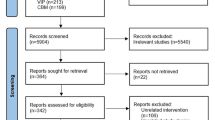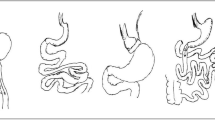Abstract
Background
Although perioperative immune-enhancing enteral formula (IEEF) is effective to decrease the rate of infectious complications, it is not clear whether perioperative use of IEEF decreases the incidence of postoperative complications and improves clinical outcome in patients who have undergone esophagectomy. A prospective randomized clinical trial was performed to examine the effects of perioperative IEEF on nutritional and immunological status in patients with esophageal carcinoma who have been treated with esophagectomy.
Methods
A total of 30 patients were randomly assigned to two groups, each receiving 3 days of preoperative and postoperative enteral nutrition through jejunostomy started within 24 h after operation, either with immune-enhancing enteral formula (group IEEF, n = 16) or with regular polymeric enteral formula (group C, n = 14). Preoperative and postoperative nutritional and immunological parameters and clinical outcome were examined.
Results
A significant increase in the serum concentration of ornithine was noted in group IEEF and it peaked at 5 days after surgery. The equivalent values were significantly lower in group C. There was no difference in serum dochosahexaic acid between the two groups. The n−3/n−6 fatty acid ratio in group IEEF was significantly higher than in group C at 7 days after surgery. Peripheral percent lymphocyte fraction and total lymphocyte count in group IEEF were both significantly higher than those in group C. While T cell fraction of peripheral lymphocytes in group IEEF at 3 days after surgery, B cell fraction in group IEEF at 5 and 7 days after surgery was significantly higher than those in group C, suggesting that perioperative IEEF caused a shift towards B cell proliferation.
Conclusions
Perioperative use of IEEF caused a significant increase in the total lymphocyte count at 3 and 5 days after operation and caused a shift toward B cell proliferation, which may possibly be beneficial to decrease the incidence of postoperative infectious complications.







Similar content being viewed by others
References
Moore FA, Feliciano DV, Andrassy RJ et al. (1992) Early enteral feeding, compared with parenteral, reduces postoperative septic complications. The results of a meta-analysis. Ann Surg 216:172–183
Torosian MH (1999) Perioperative nutrition support for patients undergoing gastrointestinal surgery: critical analysis and recommendations. World J Surg 23:565–569
Mesejo A, Acosta JA, Ortega C et al. (2005) Comparison of a high-protein disease-specific enteral formula with a high-protein enteral formula in hyperglycemic critically ill patients. Clin Nutr 22:295–305
Montejo JC (1999) Enteral nutrition-related gastrointestinal complications in critically ill patients: a multicenter study. Report of the Nutritional and Metabolic Working group of the Spanish Society of Intensive Care Medicine and Coronary Units. Crit Care Med 27:1447–1453
Coulston AM (1998) Clinical experience with modified enteral formulas for patients with diabetes. Clin Nutr 17(Suppl 2):46–56
Cockram DB, Hensley MK, Rodriguez M et al. (1998) Safety and tolerance of medical nutritional products as sole sources of nutrition in people on hemodialysis. J Ren Nutr 8:25–33
Craig LD, Nicholson S, Silverstone FA et al. (1998) Use of a reduced-carbohydrate, modified-fat enteral formula for improving metabolic control and clinical outcomes in long-term care residents with type 2 diabetes: results of a pilot trial. Nutrition 14:529–534
Cerra FB, Lehmann S, Konstantinides N et al. (1991) Improvement in immune function in ICU patients by enteral nutrition supplemented with arginine, RNA, and menhaden oil is independent of nitrogen balance. Nutrition 7:193–199
Barbul A (1986) Arginine: Biochemistry, physiology, and therapeutic implications. J Parenter Enteral Nutr 10:227–238
Lacey JM, Wilmore DW (1990) Is glutamine a conditionally essential amino acid? Nutr Rev 48:297–309
Pastores SM, Kvetan V, Katz DP (1994) Immunomodulatory effects and therapeutic potential of glutamine in the critically ill surgical patient. Nutrition 10:385–391
Almallah YZ, Ewen SW, El-Tahir A et al. (2000) Distal proctocolitis and n−3 polyunsaturated fatty acids (n−3 PUFAs): the mucosal effect in situ. J Clin Immunol 20:68–76
Dichi I, Frenhane P, Dichi JB et al. (2000) Comparison of omega-3 fatty acids and sulfasalazine in ulcerative colitis. Nutrition 16:87–90
Carver JD, Cox WI, Barness LA (1990) Dietary nucleotide effects upon murine natural killer cell activity and macrophage activation. J Parenter Enteral Nutr 14:18–22
Yamauchi K, Adjei AA, Ameho CK et al. (1996) A nucleoside-nucleotide mixture and its components increase lymphoproliferative and delayed hypersensitivity responses in mice. J Nutr 126:1571–1577
Atkinson S, Sieffert E, Bihari D (1998) A prospective, randomized, double-blind, controlled clinical trial of enteral immunonutrition in the critically ill. Report of Guy’s Hospital Intensive Care group. Crit Care Med 26:1164–1172
Beale RJ, Bryg DJ, Bihari DJ (1999) Immunonutrition in the critically ill: a systematic review of clinical outcome. Crit Care Med 27:2799–2805
Heys SD, Walker LG, Smith I et al. (1999) Enteral nutritional supplementation with key nutrients in patients with critical illness and cancer: a meta-analysis of randomized controlled clinical trials. Ann Surg 229:467–477
Braga M, Gianotti L, Cestari A et al. (1996) Gut function and immune and inflammatory responses in patients perioperatively fed with supplemented enteral formulas. Arch Surg 131:1257–1264
Suchner U, Heyland DK, Peter K (2002) Immune-modulatory actions of arginine in the critically ill. Br J Nutr 87(Suppl 1):S121–S132
Mayer K, Grimm H, Grimminger F et al. (2002) Parenteral nutrition with n−3 lipids in sepsis. Br J Nutr 87(Suppl 1):S69–S75
Bertolini G, Iapichino G, Radrizzani D et al. (2003) Early enteral immunonutrition in patients with severe sepsis: results of an interim analysis of a randomized multicentre clinical trial. Intensive Care Med 29:834–840
Stechmiller JK, Childress B, Porter T (2004) Arginine immunonutrition in critically ill patients: a clinical dilemma. Am J Crit Care 13:17–23
Akiyama H, Tsurumaru M, Udagawa H et al. (1994) Radical lymph node dissection for cancer of the thoracic esophagus. Ann Surg 220:364–372
Ando N, Ozawa S, Kitagawa Y et al. (2000) Improvement in the results of surgical treatment of advanced squamous esophageal carcinoma during 15 consecutive years. Ann Surg 232:225–232
Griffin SM, Shaw IH, Dresner SM (2002) Early complications after Ivor Lewis subtotal esophagectomy with two-field lymphadenectomy: risk factors and management. J Am Coll Surg 194:285–297
Atkins BZ, D’Amico TA (2006) Respiratory complications after esophagectomy. Thorac Surg Clin 16:35–48 vi
Avendano CE, Flume PA, Silvestri GA et al. (2002) Pulmonary complications after esophagectomy. Ann Thorac Surg 73:922–926
Harris JA, Benedict FG (1919) A Biometric Study of Basal Metabolism in Man Carnegie Institution, Washington, DC
Zaloga GP, Bortenschlager L, Black KW, et al. (1992) Immediate postoperative enteral feeding decreases weight loss and improves wound healing after abdominal surgery in rats. Crit Care Med; 5–118
Marik PE, Zaloga GP (2001) Early enteral nutrition in acutely ill patients: a systematic review. Crit Care Med 29:2264–2270
Heyland DK, Novak F, Drover JW et al. (2001) Should immunonutrition become routine in critically ill patients? A systematic review of the evidence. JAMA 286:944–953
Braga M, Gianotti L, Vignali A et al. (2002) Preoperative oral arginine and n−3 fatty acid supplementation improves the immunometabolic host response and outcome after colorectal resection for cancer. Surgery 132:805–814
Pui YM, Fisher H (1979) Factorial supplementation with arginine and glycine on nitrogen retention and body weight gain in the traumatized rat. J Nutr 109:240–246
Barbul A, Sisto DA, Wasserkrug HL et al. (1981) Metabolic and immune effects of arginine in postinjury hyperalimentation. J Trauma 21:970–974
Sakurai Y, Oh-Oka Y, Kato S et al. (2006) Effects of long-term continuous use of immune-enhancing enteral formula on nutritional and immunologic status in non-surgical patients. Nutrition 22:713–721
Sakurai Y, Zhang XJ, Wolfe RR (1995) Insulin-like growth factor-I and insulin reduce leucine flux and oxidation in conscious tumor necrosis factor-infused dogs. Surgery 117:305–313
Grimble RF (1998) Nutritional modulation of cytokine biology. Nutrition 14:634–640
Braga M, Gianotti L, Nespoli L et al. (2002) Nutritional approach in malnourished surgical patients: a prospective randomized study. Arch Surg 137:174–180
Furukawa K, Tashiro T, Yamamori H et al. (1999) Effects of soybean oil emulsion and eicosapentaenoic acid on stress response and immune function after a severely stressful operation. Ann Surg 229:255–261
Author information
Authors and Affiliations
Corresponding author
Rights and permissions
About this article
Cite this article
Sakurai, Y., Masui, T., Yoshida, I. et al. Randomized Clinical Trial of the Effects of Perioperative Use of Immune-enhancing Enteral Formula on Metabolic and Immunological Status in Patients Undergoing Esophagectomy. World J Surg 31, 2150–2157 (2007). https://doi.org/10.1007/s00268-007-9170-8
Published:
Issue Date:
DOI: https://doi.org/10.1007/s00268-007-9170-8




